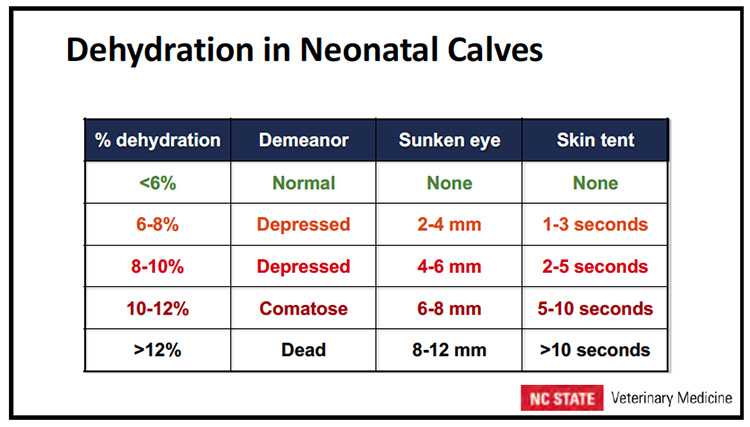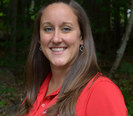
A calf does not necessarily die from diarrhea, but from the impact that diarrhea has on the body. These include acidemia, septicemia, hyperkalemia, prolonger malnutrition, and hypothermia. However, the major issue is dehydration — the loss of body fluids.
Geof Smith, a veterinarian at North Carolina State University spoke during the July webinar on “Treating diarrhea in dairy calves” and addressed the leading cause of calf death on dairy farms.
“Be very aggressive in replacing fluids,” urged Smith as he discussed assisting the calf in recovery. Loose manure is the obvious sign of dehydration, but to determine the level of dehydration, observe the eyeball recession into the orbit and the skin tent test. These gestures are easy to perform and simple to interpret. A newborn calf is already dehydrated if it loses 6 percent fluids and a loss of greater than 12 percent results in a dead calf. The lack of a suckle reflex, general weakness, and recumbency, all show that a calf is in need of immediate attention.
A calf with scours is dehydrated and is undergoing metabolic acidosis. This form of acidosis manifests itself with a drop in blood pH. Normal pH is 7.35 to 7.45, but the pH of a scouring calf is often around 7.2 to 7.3 and a calf lying on its side tends to be around a 7 blood pH. Scouring calves also have electrolyte abnormalities and are in a negative energy balance. Calves are so susceptible to dehydration because of their limited fat reserves. Their unwillingness to drink causes them to basically starve to death since milk is their primary source of nutrition at such a young age.

Dehydration also causes a loss of body fluids. A few pints of oral electrolytes is not enough to replenish what was lost. Smith suggested at least 3 liters to correct an existing deficit and 4 to 5 liters is preferred.
Replenishing water is important, but the electrolytes which include vitamins and minerals are the key to recovery. Not all oral electrolytes are created equal, so be selective in your purchases. Look at sodium, potassium, and chloride content and energy sources that are not an irritant to the calf’s intestines. Some are designed for dilution in water, while others can be fed in milk. “Do not assume all electrolytes can be fed in milk,” he warned.
Furthermore, milk should not be withheld from a scouring calf. It needs energy and nutrition during this time. Smith even encouraged feeding an extra meal through the duration of the diarrhea to aid in recovery. “I have not seen any study that shows that withholding milk is beneficial for recovery. Calves need electrolytes and their milk,” stressed Smith. It is okay to skip just one feeding if a calf is depressed and refuses to drink. However, milk should be resumed within 12 hours.
If calves are housed in straw it can be easy to miss the signs of scours. Smith suggested placing a clothes pin on the pen or hutch of a calf that seems “off” when drinking its milk. The employee can evaluate the calf and its behavior at the end of chores by finding the clothes pin.
Calf treatment goals include:
1. Correct dehydration
2. Replenish electrolytes
3. Correct acid-base abnormalities in the digestive tract
4. Provide nutritional support (additional energy source)
“Recognize dehydrated calves early and aggressively administer electrolytes for best chance of recovery,” shared the veterinarian.
This webinar can be viewed on our website. The presentation was sponsored by TechMix.

Lindsay Ferlito, Cornell University Cooperative Extension, will present “Monitoring and improving cow comfort in freestalls and tie stalls” on Monday, August 12, at noon (Central time).
Cow comfort has a huge impact on a dairy’s bottom line. Monitoring lameness and injuries helps producers identify management and facility factors that influence cow comfort, allowing them to make the right changes and see improvements.

The author is the online media manager and is responsible for the website, webinars, and social media. A graduate of Modesto Junior College and Fresno State, she was raised on a California dairy and frequently blogs on youth programs and consumer issues.